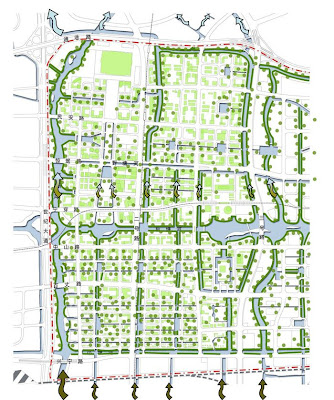
Leap frogging to future sustainable cities in China.Eleonore de Lusignan
After the success of Bill McDonough's book Craddle to Craddle, China has implemented it into there government policy and McDonough's + Partners was given the responsibility to design
7 new cities with the expectancy that 400 million new Chinese citizens will need new homes within the next 12 years. For starts, Bill has begun designing two city plans:
Guantang Chuangye Sustainable Conceptual Master Plan, and
Tangye New Town Concept Master Plan."
Guantang Chuangye Sustainable Conceptual Master Plan
Liuzhou, Guangxi Zhuang Autonomous Region, People's Republic of China
Overview:
This concept master plan aspires to indicate, through design strategies, a future that is positive and hopeful in all aspects.
Striving to maximize social engagement, the plan creates an urban structure that promotes walking and healthy activities in its multitude of parks, paths and trails. The development will also preserve existing stream and wetland communities, returning clean, healthy water to the ecosystem at equal rates and in the same patterns of the undeveleped site through the use of integrated strategies. Befitting its designation as a demonstration project, the plan demonstrates what is possible in Liuzhou, in China, and in communities around the globe. The project serves as a challenge to seek excellence in placemaking that will enable Liuzhou’s children to live and work in concert with a world full of potential and opportunity."

Ningbo View (image courtesy of EDAW and William McDonough + Partners)
"Each of the demonstrations feature cradle to cradle design principles that are gaining recognition in part due to the recent Chinese printing of the book “Cradle to Cradle: Exploring Design for the Circular Economy” by William A. McDonough and Michael Braungart.
The sustainable design of urban centers is of vital importance to China and the world. In the coming two decades, 300-450 million people will move from the countryside to China’s cities. This year alone, China will build 5 billion square feet of new housing and consume 40% of the world’s production of cement. Over 65% of China’s cities are in a water shortage and 90% of urban watersheds are considered contaminated by Chinese government standards.
The China-US Center for Sustainable Development’s strategic goals are to set the standards for sustainable development and build the human and organizational capacity to achieve them. The Center’s mission is to accelerate sustainable development so that commerce, communities and nature can thrive and prosper in harmony – what China is now calling a “circular economy.” "
 Liuzhou, Guangxi Zhuang AR
Liuzhou, Guangxi Zhuang AR
Tangye New Town Concept Master Plan
Jinan, Shandong Province, People's Republic of China
"Overview
This concept plan outlines a sustaining vision for a new administrative and cultural center for the government of the Licheng District in rapidly growing Eastern Industrial Zone east of Jinan. Working under the guidance and support of the China Housing Industry Association and the China-U.S. Center for Sustainable Development, the design team has developed conceptual plans for a new urban district that would house 180,000 people and embodies the principles of Cradle to Cradle Design.
The plan develops a framework for achieving the ultimate goal of safe, healthy and delightful solar-powered cities. By considering issues beyond the initial use and operations of the development, the plan supports later adoption of emerging technologies and systems not readily available at the time of construction. For instance, proper orientation and solar access will enable the town to install photovoltaics should current trends continue make solar energy equal in cost to coal-fired electricity by 2016.
The pattern and organization of development responds to site-specific environmental features, systems, and flows. Vegetated fabric defines a patchwork of developable areas that imply a network of residential neighborhoods and commercial/public precincts. A series of linear parks running from east to west convey storm water to existing gullies and provide a setting for neighborhood amenities and a structure for pedestrian and bicycle routes throughout the new district. The plan also facilitates the integration of innovative infrastructure for water, wastewater, and energy production and use.
In addition to benefiting the people of Jinan, this anticipatory design provides a replicable model for a country embarking on a campaign to house 400 million people in the coming decade, giving China the opportunity to redefine cities in ways that lead the world in the realization of truly sustaining future."

" Under the guidance and support of the China Housing Industry Association and the China-US Center for Sustainable Development, William McDonough + Partners with the support of WSP Environmental LLC was commissioned to create a concept master plan that embodies the principles of the Cradle-to-Cradle Design Protocol and sustainable design.
The concept plan aspires to indicate, through design strategies, a future that is positive and hopeful in all aspects; one that:
- Maximizes social engagement and community
- Creates an urban structure that promotes walking and healthy activities
- Effectively leverages the scarce land available for development
- Promotes alternative and renewable technologies
- Treats water as a precious resources
- Improves the quality of storm water leaving the site
- Uses biological resources to build and restore soil quality
- Restores habitat and biodiversity
- Learns from and respects the quality of the land and people"

LINKS:
 We lay the city out so everyone can move in parks without crossing traffic, the buildings have daylight lighting, the university is at the centre, and with hi-tech connectivity
We lay the city out so everyone can move in parks without crossing traffic, the buildings have daylight lighting, the university is at the centre, and with hi-tech connectivity 
William McDonough, architect
BBC NewsMetropolis: Eternal Optimism
The Great Green Leap Forward: Energy-Hungry China and India Leapfrog to the Front of the Global Green Building Movement
By Kevin Sullivan

























